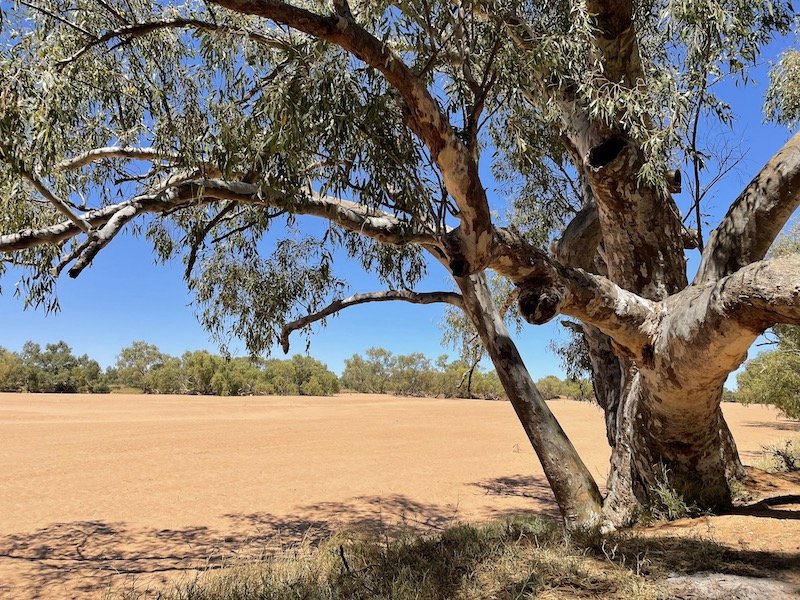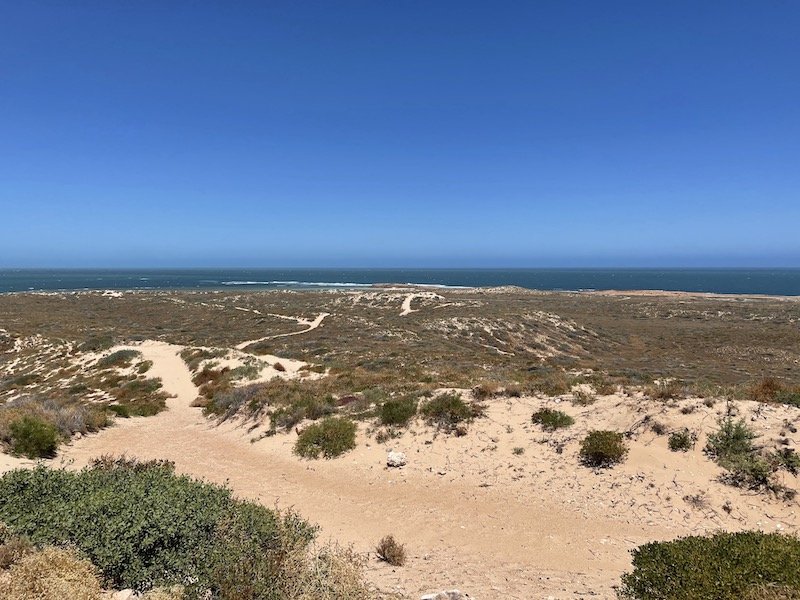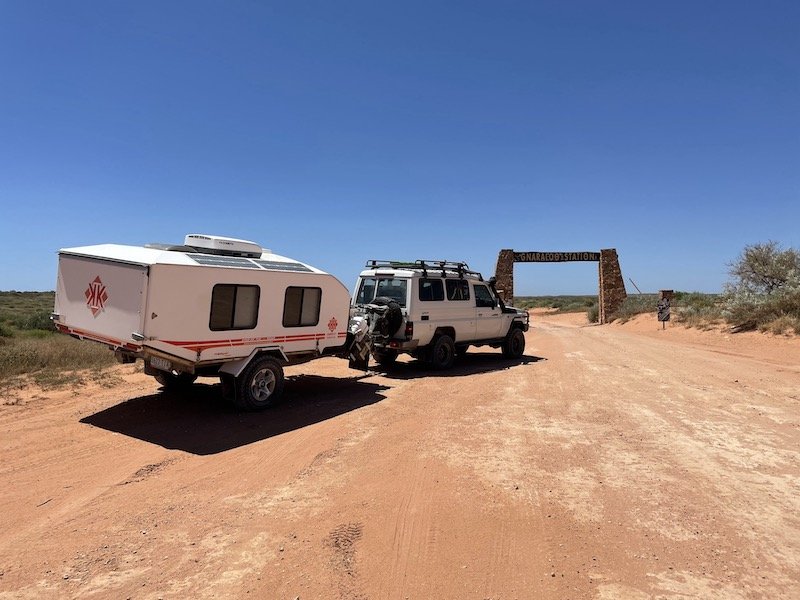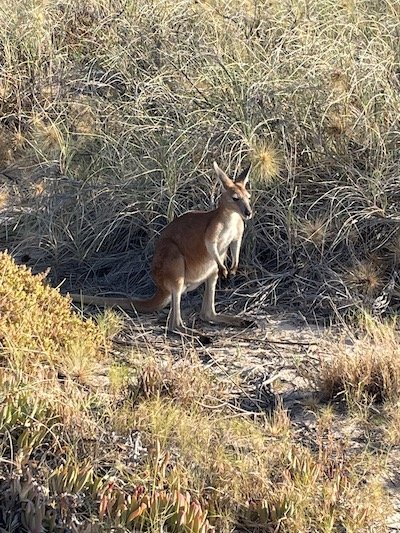A little bit of Ningaloo
Coastal Western Australia is windy; it’s windy almost all the time and is really windy in the windy season from November to January which sometimes extends into October and February. The prevailing wind is Southwesterly, so its mostly an off-shore breeze of 20-30kph but often topping 40-60kph with occasional cyclones. This is mostly advantageous as it takes the edge off the heat and, most importantly, it blows all the flies that proliferate wherever there is livestock, which is most of WA, further inland where they are truly horrible and absolutely unbearable when it’s really hot. On the few times we have ventured inland a bit in WA, the flies have been troublesome unless its really windy and, even then, locals have said ‘they’re not too bad at the moment, you wait till its really hot’ but they seem to have a different badness scale from ours. Anyway, the choice is wind or flies and we have picked wind almost every time but to be honest, we are getting a bit tired of the relentless windiness. Willy Weather, yes that’s really what the best weather app is called, showed that towards Perth was chilly, especially at night for a few more weeks and we didn’t fancy that, so we decided to go a bit further North for warmer climes.
Our first stop was Wooramel River Retreat which I chose because I thought camping by fresh water would be a nice change from the seaside. It was most certainly a change, not least because there was not a drop of water in the river! The riverbed was over 100m wide and about 2m deep but as dry as dust as it would normally only have water in two or three times a year. Although, this year, on its fifth filling it broke the bank and flooded the camp site. Thankfully, the owners mates upstream are able to give 72 hours warning of heavy rain allowing time for evacuation. It was, however, one of the most beautiful scenes I have seen so far on our travels.
One of many old River Red Gum trees lining the banks of the dry 100m wide Cream Creek
The giant River Red Gum trees that lined the banks typified the view of the Australian countryside that I have carried in my mind since childhood when my father used to draw scenes for me that he called ‘perspective pictures’. These always featured gum trees that got progressively smaller eventually disappearing into the distance, usually round the bend in a creek or over a hill. I no longer have any of his drawings but sitting under those trees felt like being in one which was just beaut!
Travelling North we arrived at Australia’s Coral Coast area, where the Ningaloo reef, a UNESCO World Heritage site, extends for 260km along the Northwestern coast of WA. This fringing reef is very close to the mainland and there are many places you can just walk off the beach to snorkel over the reef before you are even waist deep. This amazing natural structure is almost continuous from just South of Coral Bay right up to the Exmouth Peninsular and is home to the most astonishing marine life.
We stopped in at the small town of Carnarvon where we expected to just stock up on food and fuel as there is very little opportunity to do so further up the coast, but instead we found a place with a really interesting history. The town played an unlikely but important part in the space race in the 1960s and 70s because it was ideally placed to house a giant satellite dish and tracking station to ensure contact with the astronauts on the Apollo and other missions. A brilliant space and technology museum opened by Buzz Aldrin provides a really good few hours fun and education for all ages about the quiet but vital part played by Australia in early space exploration.
As in the rest of Australia, the white settlers in this area did untold damage to indigenous people and, in recent years, the stories have been told in an attempt to heal the wounds. The Gwoonwardu Mia Gascoyne Aboriginal Heritage and Cultural Centre provides displays, artwork and video stories by Aboriginal people affected by these actions which brings the history into sharp focus.
On the horizon as you look out across the sea from Carnarvon are the narrow, low lying islands of Dorre and Bernier which extend North-South like two further dashes on the same line beyond Dirk Hartogg Island. These are now protected habitats for some of the rarest creatures in Australia and were a an important factor in Shark Bay being listed as a World Heritage area. In the not too distant past, the islands were used for some of the most horrendous treatment of Aboriginal People, now referred to as the Bernier and Dorre Lock Hospital Tragedy. Using spurious diagnoses of venereal disease, Aboriginal people were rounded up and sent to the Lock Hospitals on these prison islands, mostly never to be seen alive by their families again. This was part of the Australian Governments deliberate policy to break up indigenous communities and expunge their traditions and way of life.
The sculpture entitled Don’t Look At The Islands at the entrance to the One Mile Jetty, created as part of the Lock Hospital Memorial Project, captures the anguish of two children who’s family had been destroyed by this barbaric practice. The memories of the indigenous people captured during the early stages of this project described how they could not bear to look at the islands but could only cover their eyes and point to them lest looking confirmed the truth that their parents were gone forever.
One of the most enjoyable things about travelling is meeting people. In Carnarvon we met the lovely Taylor family, a couple and their two children who were about half way through a year long trip around Australia in their camper trailer. They parked up next door to us in a caravan park after 27 consecutive nights of free camping making us realise we needed to toughen up and kick our expensive caravan park habit. These folk are experts at finding interesting things to see and do which we were sure was providing an amazing enjoyable and educational experience for the whole family. A key aspect of their MO is to travel slowly; that way they get a rounded view of places, don’t miss interesting stuff or waste fuel. We have enjoyed following their travels and experiences from a distance.
While we were in Carnavon, a terrible incident occurred at the campsite we planned to go to next. In the middle of the night a four year old girl, Cleo, disappeared from the tent where she and her family were sleeping. The coastal Blow Holes camp ground below the the beautiful Quobba Station became the site of a massive search operation, later to be extended to a National abduction investigation reported around the world. The usually carefree atmosphere of children playing without intense adult supervision was damaged and the topic dominated all conversations across the country but especially in this, her home town. Thankfully, this little girl was found 18 days later, apparently unharmed, at the house of a local man quite near the family home.
Unable to visit this site, we to drove along the 60km dirt track through Quobba Station to the neighbouring Gnaraloo Station where we pitched at Three Mile Camp, a favourite spot for kite surfers. The spacious camp ground was lovely with beautiful coastal views, a white sandy beach and a stunning sunset, but the wind was just too much for us so we headed for Coral Bay. We could have made a 130km partially off road journey straight up the coast to through Warraroo Station but the signage said the tracks were challenging and recovery wasn’t guaranteed. Had we been travelling with other people, we may have risked it but chose to make 340km long loop around Lake MacLeod on dirt and made roads.
Blow-holes, Quobba station WA
From Quobba into Gnaraloo
Gnaraloo Station coastline
In Coral Bay, we booked into a pretty crowded Ningaloo Coral Bay holiday park with all the usual facilities. Although it was a bit pricy, the close proximity of other rigs afforded us some protection from the relentless wind. The small town is basically just two large camp grounds right beside each other, one a bit swankier than the other, and a few bars, cafés and shops catering for tourists surrounding the most amazing gently sloping white beach frequented by friendly roos.
Especially on such a tightly packed camp ground, there are lots of folk to chat to and we struck up friendships with our near neighbours. Lawrence and Jodie from who had been on the road for months in their giant luxurious rig complete with slide-out reclining sofa space (which we secretly coveted!). Despite the size of the country, we managed to bump into these lovely people twice more on our travels and learnt a new card game too. We met a lovely guy called Max who was experiencing the challenges of a family holiday with three teenagers all with very different interests; something we have experienced ourselves. We have often reflected upon how we could have managed these times better, but you do what you think is right at the time, without the benefit of a retrospectoscope!
This is a photo from the web to illustrate what the reef looks like but my pictures weren’t so good
The coral reef is clearly visible from the beach and in just a few steps you can float on the surface looking multicoloured fish straight in the eye. The coral is not the technicolored structure of the Great Barrier Reef because it is not subject to the same warm currents, but it is beautiful nevertheless. The variety of shapes is similar but the colours are more muted with more greens and blues amongst the greys and beiges.
For the beginners snorkelling, the advice is to walk south along the beach before getting in, then let the current take you round into the bay. We did this the first time but later enjoyed the nearer experience of just bobbing about in the bay. My first underwater GoPro filming was a little disappointing because the lens has such a wide angle that the close up fish encounters I had looked a bit distant on the film. Never mind, I’ll work on my Jacques Cousteau technique for next time.
From Coral Bay we decided to head South, back to Perth in time for the warmer Willy Weather prediction. Ian’s online shopping habit has been curtailed since we arrived in Australia but, once he established that our friends, Tom and Jess, in Perth would be happy to receive deliveries, he has resumed shopping, buying things that were hard to get or very expensive in shops.. We are looking forward to seeing them again as they prepare for the arrival of their first baby and I am sure they will be relieved to hand over the parcels.
These clouds reminded me of dandelion clock seeds blowing in the wind
This episode is somewhat late as I’ve had a significant wobble during the last few weeks of our travels; feeling very homesick, unsettled by being homeless and generally questioning the frivolity of our trip while the world is burning. Consequently, I’ve not felt much like recounting what we’ve been doing. Although these feelings have not gone, I am keen to document our trip to share our experiences and jog our memory in the future so I’ve given myself a good talking to and normal service has now been resumed, for the time being at least. Thank you also to all the kind messages and words of encouragement. Please keep them coming.







